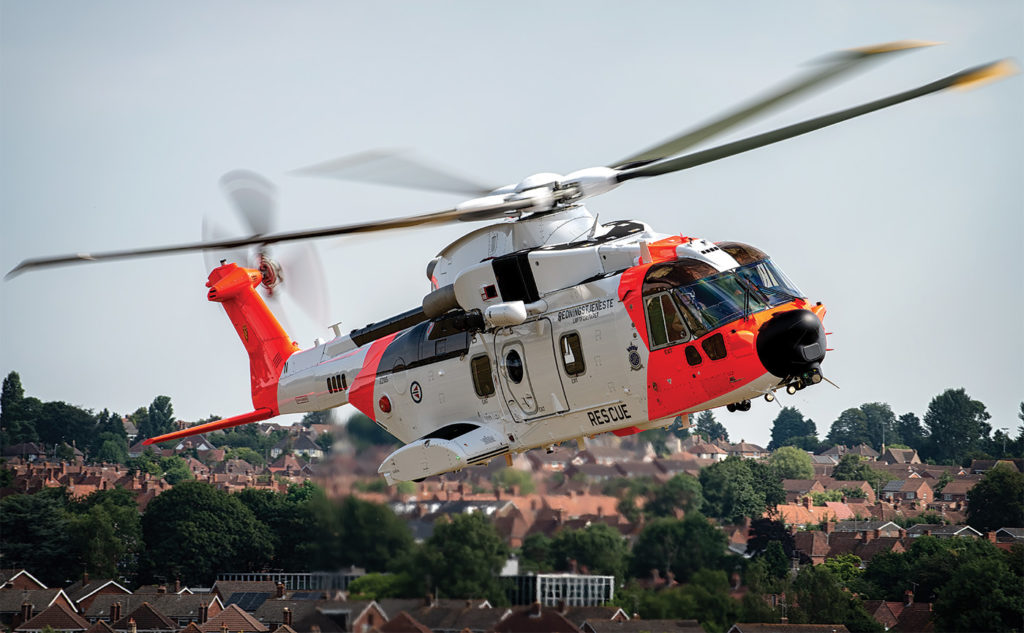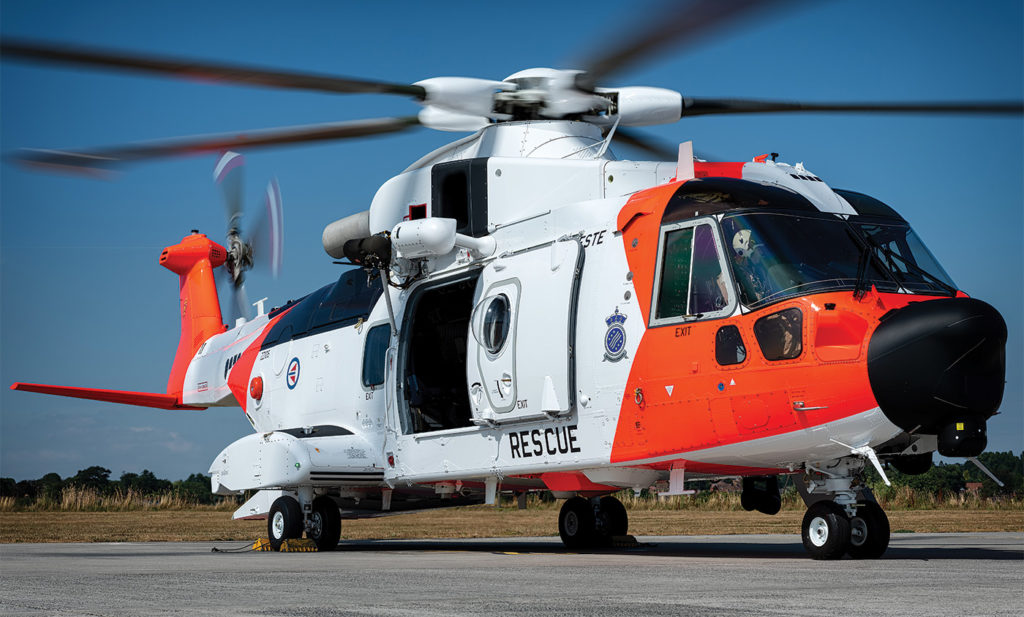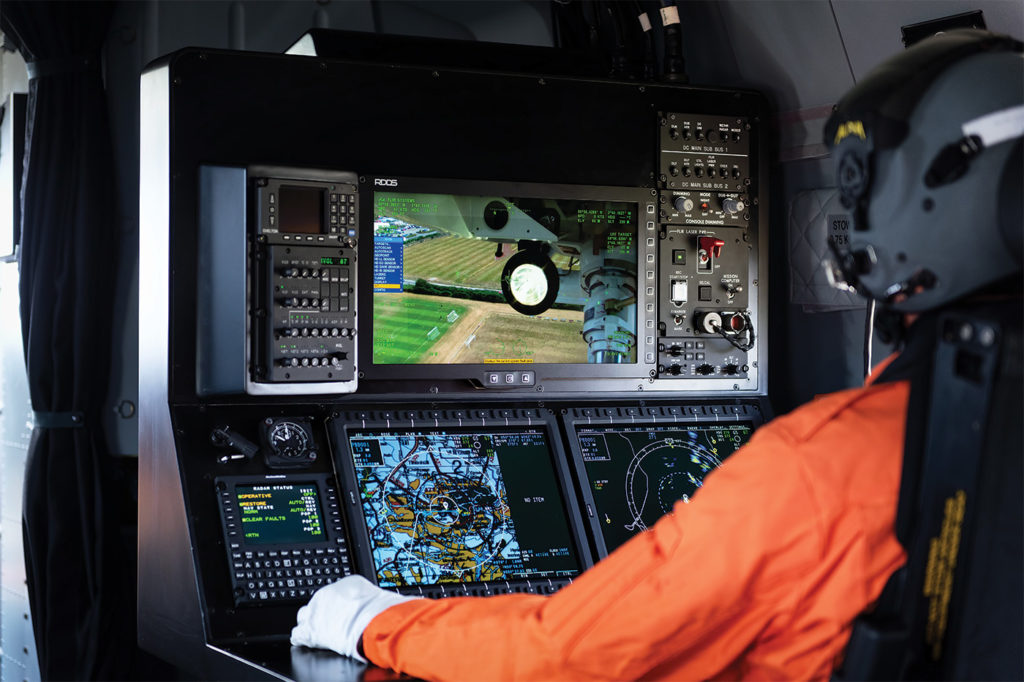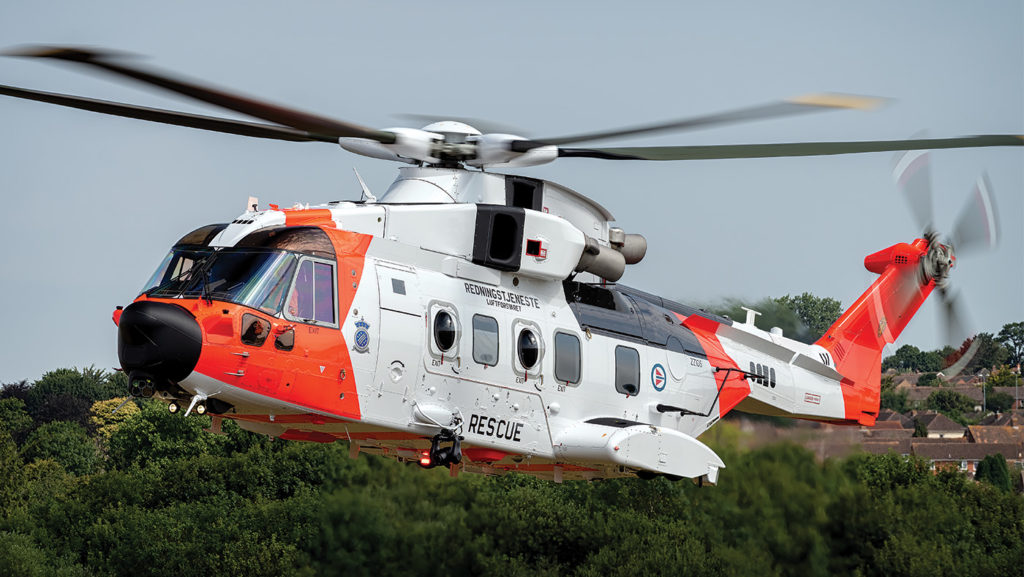Estimated reading time 11 minutes, 18 seconds.
If you’re planning to become hopelessly lost, my advice is to do it in Norway.

That was the author’s conclusion after Skies was invited to the Leonardo Helicopters facility in Yeovil, England, to fly the latest variant of the AW101 search and rescue (SAR) helicopter.
The machine was brand new, pending delivery to Norway, but represented a configuration that Leonardo has proposed to the Royal Canadian Air Force (RCAF) as an upgrade for Canada’s fleet of CH-149 Cormorant SAR helicopters.
AN OPPORTUNITY FOR THE RCAF
The CH-149 Cormorant entered RCAF service in 2002. While not an old airframe by Canadian standards, the subsequent evolution of the model has left our version somewhat dated, and Leonardo maintains that obsolescence issues are beginning to adversely affect operational availability
Team Cormorant is an industry consortium composed of Leonardo Helicopters, IMP Aerospace & Defence, CAE, GE Canada and Rockwell Collins Canada.
The group’s unsolicited proposal to the Air Force is intended to guard against creeping obsolescence and ultimately to reduce the cost of operating the helicopter. Under Team Cormorant’s proposal, the RCAF would also acquire a training facility with a modern full-mission simulator, likely to be installed at 19 Wing Comox, B.C.
The machine on offer to Canada is an extensively upgraded version of the RCAF’s existing airframe, based upon the AW101-612 configuration; 16 of which are destined for Norway under its Norwegian All-Weather SAR Helicopter (NAWSARH) program.
Team Cormorant’s proposal to Canada also seeks to take advantage of nine former VH-71 Kestrel airframes from the cancelled U.S. presidential helicopter program, acquired by the RCAF in 2011. These would be used to augment the Cormorant fleet from the current 14–widely acknowledged as inadequate for Canadian SAR requirements–up to potentially 21 machines.

Enhanced fleet size would allow the RCAF to base the Cormorant at 8 Wing Trenton, Ont.; a move that would improve SAR capability in the vast Trenton SAR region.
Compared to in-service CH-149 Cormorants, the upgrades on offer include new, more powerful, full-authority digital electronic-controlled (FADEC) General Electric CT7-8E turboshaft engines; a more modern Rockwell Collins cockpit and avionics suite; improved aircraft management system; and a newly designed, four-axis dual-duplex digital automatic flight control system (AFCS).
The sensor package promises the biggest capability upgrade, and includes an electro-optical surveillance system; a multi-mode active electronically-scanned array (AESA) radar; cell phone detection and tracking system; and marine automatic identification system (AIS) transponder receiver.
AN OPPORTUNITY FOR COMPARISON
In 2016, Skies dispatched me to fly the CH-149 Cormorant with RCAF’s 442 Squadron at CFB Comox. It was an opportunity for this former Air Force CH-113/A Labrador SAR pilot to see first-hand how the Cormorant had changed the job I did decades ago in those same mountains.
I recall that the Cormorant brought a lot of new technology to the SAR business, but the basic mission, like the mountains around us, was unchanged.

After that flight, I reported: “Flying SAR was still a matter of cautious and skillful flying, using maps and looking out the window.” That experience left me with great regard for Air Force SAR crews and for the operational capability of the Cormorant, but also bemused to find that the business of searching still basically relied upon the “Mark 1 eyeball.”
A flight in the latest variant of the AW101 was a terrific opportunity for a more contemporary comparison. The experience would demonstrate that leading-edge systems–particularly electro-optic sensor technologies–offer SAR capabilities that are as much a generational improvement over the current Cormorant as the Cormorant was over my beloved ol’ Labrador.
A CANADIAN FLIES A NORWEGIAN HELICOPTER IN ENGLAND
Leonardo Helicopters test pilot Richard “Russ” Grant kindly offered me the right seat for our demonstration flight. Veteran flight test engineer (FTE) Andy Cotton served as sensor operator. Conditions were ideal, under a clear sky with a warm (24 C) gentle breeze along the century-old former-Westlands grass runway.
Our test helicopter was the sixth production machine destined for Norway, operated by Leonardo under U.K. Ministry of Defence registration ZZ015. The helicopter’s empty weight was 11,039 kilograms with much of its SAR interior yet to be fitted. Adding 2,000 kilograms of fuel (roughly half its 4,150-kilogram capacity) and three crewmembers brought the takeoff mass to 13,517 kilograms, which was well below the maximum allowable gross weight of 15,600 kilograms.

The Cormorant that Skies flew with RCAF’s 442 Squadron, although fully equipped for SAR with a standard fuel load of 2,400 kilograms and a crew of six, had a gross takeoff mass of 13,800 kilograms, which was below the maximum allowable gross weight of 14,600 kilograms. Direct comparison is difficult to establish, but the Norwegian machine is both heavier with installed systems and has more installed power than the CH-149, so the net result may be expected to be about the same operational power margin.
Rapid dispatch can be facilitated by starting the auxiliary power unit (APU) while strapping in. Grant talked me through the engine starting procedure from memory. Air Force crews will use a checklist, but the procedure was quick and straightforward
Engine controls consisted of three rotary knobs on the overhead panel in place of engine condition levers. I monitored the start, but Grant advised that in the event of a start-up malfunction the FADEC would shut down the engine faster than the pilots could react. We started the No. 1 engine first to power the accessory drive, providing hydraulic and electric power and bleed air. Starts of engines No. 2 and No. 3 were done simultaneously. Pre-flight checks and initialization of the aircraft management system (AMS, but think “master computer”) took Grant only minutes.
Despite the functional similarity of the cockpit to the CH-149, the impression that I was amidst unfamiliar new technology was immediate. As ground crews pulled the chocks and busied themselves around the helicopter, the onboard Obstacle Proximity LIDAR System (OPLS, where LIDAR is light detection and ranging, since I needed to ask, too) annunciated their presence around the turning rotors.
This system, which Grant described as being like the parking sensors in a car, provided a pop-up display and discretely-pitched audio cues depicting the range and azimuth to obstacles around the helicopter. Having come from a generation where we squinted into a landing light beam to guesstimate rotor clearance from obstacles, all I can say is, I want one!

autoflight systems was a key part of
understanding the machine’s capabilities. Lloyd Horgan
The Norwegian AW101 flies identically to the Cormorant. With its new AFCS, the flight controls are slightly heavier, but I know that only because Grant told me.
We tried all the flight control modes, with the only surprise being how pleasantly it manoeuvred for such a large machine. I spent most of my time in the hover alternating between attitude mode and the impressive automated hover mode.
By depressing a button on the cyclic, a hover mode would lock the helicopter in place using a four-axis hold function, maintaining velocity, heading and radar altimeter height. Each click on the cyclic-mounted switch smoothly varied the selected velocity by one knot. A switch on the collective trimmed the reference heading. Hovering could only get easier if I unrolled a cot and took a nap.
Cotton demonstrated his ability to command the hover mode using the flight engineer’s hoist controller. His precision was evident in the cockpit through the video feed from the hoist, displayed on the multifunction display. Times have changed, indeed.

The cockpit is a significant upgrade from the current CH-149. The AFCS is far more capable, and the cockpit systems are–with a few exceptions–actually integrated into a singular cohesive system.
Nobody could say that about the legacy Cormorant. Monochrome screens, a clunky AMS interface, and limited systems integration combine to give the CH-149 cockpit a feeling I can only describe as “very 1990s.”
By comparison, the NAWSARH, configured with a five-screen Rockwell Collins avionics suite, including a modern AMS with a trackball interface, represented the state-of-the-art.
SAR IN THE CANADIAN CONTEXT
An upgraded RCAF Cormorant would be a more systems- and sensors-intensive Cormorant, with consequentially additional duties and workload for the crew. The RCAF may find it necessary to adapt how it conducts SAR.
For Norwegian service, the machine is configured with a mission console for a dedicated systems operator, who serves as the mission commander. Biased by my prior experience, I was dismissive of the idea until we flew–but the crew was already quite busy enough, in my opinion, and a dedicated systems operator proved invaluable.
The systems operator requires considerable skill and training, however. The RCAF will find that someone will be required to work the new sensors, and that “someone” must be trained and proficient in the use of radar and electro-optical search techniques.
SENSORS MAKE THE DIFFERENCE
Every SAR mission is unique, so at the risk of oversimplifying, a good SAR helicopter needs to do three things: get to the scene, find the victim(s), and effect a rescue. While the upgraded AW101 is overall more capable, it was sensor technology, and its promise of substantively enhancing SAR capability in the search phase, that were most impressive.

Departing southbound from Yeovil, Grant selected a digital map overlay of the marine autonomous identification system (AIS) transponder network off England’s busy south coast. More than 200 vessels were visible to the system, with the names and particulars for each vessel being available with a “right click” on the cursor over the vessel icon. A further click was sufficient to activate the selected vessel as an AMS waypoint. It didn’t require much explanation to see how AIS would be helpful in a marine rescue.
In lieu of rescuing someone against their will from an actual vessel, Grant selected a feature on the shoreline to demonstrate a coupled approach. It took Grant one click with the trackball to activate an autopilot-coupled approach.
While the helicopter performed a procedure turn into the wind in preparation for descent, Grant used AESA radar data, overlaid upon the primary flight display, to supplement the GPS navigation. The AW101 actually had two radars onboard: a simple weather radar solely for the “front end” crew, and Leonardo’s own “Osprey”–a gee-whiz, electronically-scanned, multi-mode search radar.
While the radar backed up the GPS, Cotton scanned the location for obstacles from the cabin with the electro-optical sensor, alternating between a well-stabilized daylight television image and an infrared image for best resolution. Later, eager to demonstrate that the sensor could see things that our eyes could not, Cotton pointed out a feature on the screen. “France,” he explained, at a range of 108 kilometres. “I’ve got it on radar, too,” he furthered. Nice.

En route back to Yeovil, Cotton demonstrated the onboard cellular telephone tracking system. There were understandably quite a few cell phones in use in the U.K. at the time, but the company’s particular “Nokia e51” phone was quickly “rescued” from where they had hidden it for my benefit off the factory site.
While only minimally integrated into the avionics, the system provided a bearing pointer and range to the phone through a pop-up window on the multi-function display. In most cases, the phone will obligingly transmit its coordinates, and can exchange both text and voice messages with the helicopter. The operational value of such capability needs little elaboration.
INVESTING IN PRIORITIES
While the CH-149 Cormorant has proven capable, it was never an inexpensive helicopter to operate. That cost reflects the commitment by the RCAF to SAR as a core capability.
If an investment in that capability is warranted, what better investment than taking a proven, existing airframe and leveraging it to deliver more capability at a reduced operating cost?
The RCAF is on the right track.

